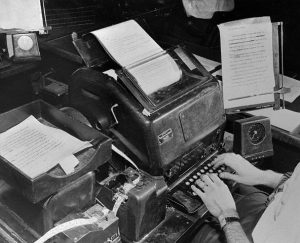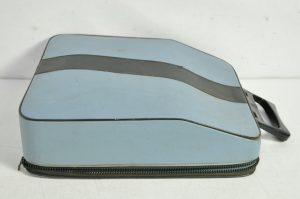Back in 1975 B.C. (Before Cyberspace), I lugged a 17-pound Olivetti Lettera 32 portable typewriter from the jungles of Cambodia to the central highlands of Vietnam as I covered the fall of both countries to communist forces.
That Olivetti never failed me, though it took a severe pounding as I jumped on and off helicopters, bounced down rutted roads in jeeps and trucks, and exposed it to 110-degree temperatures and monsoon rains.
Its solid, blue metal shell behaved like armor plating. No matter how much I threw that typewriter around or how often I dropped it when I unzipped the vinyl case and pulled it out, the platen always held my paper in position, and the keys always worked.
In 1975, this was state-of-the-art technology. Tough. Dependable. Cheap. Easy to maintain.
Today that Olivetti resides on a shelf in my garage. And I am sure if I cranked a sheet of paper into it and began banging on the keys, those low-tech black letters would start marching, albeit haltingly, across the page, just like the old days.

But as reliable and sturdy as that old Olivetti was, would I consider lugging it back to Vietnam if I were to return for the 47th anniversary of the fall of Saigon on April 29? Not on your life. Of course, that’s a moot point now because of the Wuhan Coronavirus unleashed on the world by China.
Instead, I would carry my Dell laptop computer. Unlike my old typewriter, the Dell XPS 7590 weighs only 4 pounds.
And, unlike my portable typewriter, it is crammed with software products that allow me not only to write my stories and record notes, but to do my expense reports, communicate with the outside world, keep track of contacts and sources, and even play games when I get tired of doing real work—all in living color.

If I were able to go back to Vietnam, I would sit in my hotel room in Saigon with the Dell’s screen aglow and wonder how I ever got along without this kind of technology in 1975.
The answer seems obvious enough. Most of the work a correspondent does involves observation and interviewing, otherwise known as reporting.
These are things that no machine—not my low-tech Olivetti typewriter nor a high-tech Dell laptop–can do for you.
There is little doubt that the actual process of writing this time around in Vietnam would be made infinitely easier by the Microsoft Word program inside the Dell.
After all, in just a few seconds, I could spell-check my story and even use Word’s electronic thesaurus to juggle adjectives and verbs. Try that on a portable typewriter.
Today, I think about all those times in 1975 that I found myself in the Vietnamese outback with a story written, but with no way to get it back to the Chicago Tribune. Few Vietnamese cities outside of Saigon had a public telecommunications office where you could take a hard copy of your story, punch it into a telex machine, and have it transmitted to Tribune Tower 12,000 miles away.
That meant you had to “pigeon” your story. “Pigeoning” a story meant that after I reported it and wrote it on my portable typewriter, I would jump into a taxi and head for the nearest airport.
There I would run frantically through the terminal looking for a pilot—often one of the CIA’s Air America airplane drivers—and give him my story to take back to Saigon.

Once in Saigon, the pilot would drop the story off at the PTT (Public Telephone and Telegraph) office, and a congenial young woman named Miss Minh would unfold the crumpled pages and try to decipher all of the barely legible editing notes I scribbled in the margins.
Then Miss Minh would switch on her telex machine and convert the whole thing into about 20 feet of paper telex tape. That done, she would dial-up 253638, which was the Tribune’s old telex number.

If all systems were “go,” then maybe 10 or 15 minutes later, one of the Tribune’s old gray telex machines would hump its carriage a few times, ring a few bells, and my story would clank forth, printed on an 8-inch-wide roll of yellow paper.
The total elapsed time from when I finished the story until that old telex machine regurgitated it in the Tribune’s wire room would be close to 8 hours. It might be longer if the pilot stopped off at the Continental Palace Hotel’s veranda for a few beers before trudging down Le Loi Boulevard to the PTT office.
The cost for all of this could run close to $200 because, in addition to the $160 or $170 it cost to transmit the story, I was obligated to buy dinner or several rounds of drinks for the pilot when I returned to Saigon. Today, I could send that same 1,500-word story with the Dell in less than a minute the Internet. The cost? Negligible.
Back in 1975, it not only cost more to get a story from Saigon to Chicago, but the psychic outlay of pigeoning a story was substantial.
After all, I had no way of knowing if the story I handed to a pilot was sent until I returned to Saigon several days later.
About the only thing that comes close to equaling that sensation in this, the computer age, is that plummeting feeling you get when the hard drive in your laptop fails, and you haven’t backed up your work.
In 1975, my backup system consisted of a few sheets of threadbare carbon paper and a tattered 8-by-11 manila envelope. There were no CMOS batteries, no fragile hard disks, and no central processors to worry about— unless you counted me.
There is no doubt that advanced computer technology, for all its brilliance, comes with drawbacks. For example, what would I have done with a laptop in Phnom Penh in 1975? The city, which was under constant bombardment by the communist Khmer Rouge, only had electricity an hour a day. That would have barely given me time to recharge my computer’s battery or the two nickel-metal hydride battery packs I could use as a backup.

Then there is the most significant liability of all. I have a feeling I would treat an expensive laptop a lot differently than I treated my Olivetti typewriter.
For example, in 1975, I occasionally used my $99 Olivetti to shield myself from airborne shrapnel and the other fluttering detritus of war.
But I suspect that given the $1,149 price tag of a Dell XPS 7590, I might use my body to protect it during mortar and artillery bombardments.
Just consider the mathematics. You could buy about twelve Olivetti portables for the price of one Dell XPS 7590. And that’s not counting the software.
But then, when I think about all those times I trudged down Tu Do Street to attend the military briefings we used to call the “5 O’clock Follies,” and all the times I swore I would never again waste my time going to them, I’m convinced that the technological advantages of a 2020 laptop definitely outweigh the shrapnel-shielding capacity of a 1975 Olivetti.
For example, had there been laptops and on-line news retrieval in 1975, I could have plugged in my modem to the nearest phone jack and picked up the salient points of the Follies while sipping a vodka tonic at a table on the veranda of the Continental Hotel—otherwise known as the “shelf.”
On second thought, that might not have been a good idea. The obstreperous collection of hacks, soldiers of fortune, and castoffs that used to gather in the shelf and other watering holes in Saigon in those days tended to slosh drinks and spill plates of food.
And while my old Olivetti was irrigated more than once with Vietnamese “33” beer” and assorted food products, I shudder to think what a single glass of vodka or a small dish of Saigon fish sauce might do to the innards of a $1,200 laptop.



Thanks for Reading!